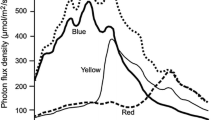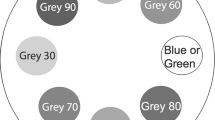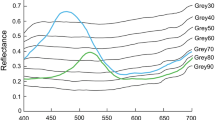Abstract
Many demersal fish species undergo vertical shifts in habitats during ontogeny especially after larval metamorphosis. The visual spectral sensitivity shifts with the habitat, indicating a change in colour vision. Colour vision depends on sufficient ambient light and becomes ineffective at a particular low light intensity. It is not known how fishes see colour in dim light. By means of a behavioural experiment on larval African catfish Clarias gariepinus in the laboratory, we determined colour vision and colour discrimination in dim light. Light-adapted larvae were subjected to classical conditioning to associate a reward feed with a green or a red stimulus placed among 7 shades of grey. The larvae learned this visual task after 70 and 90 trials. A different batch of larvae were trained to discriminate between green and red and then tested for the ability to discriminate between these colours, as the light intensity was reduced. The larvae learned this visual task after 110 trials in bright light and were able to discriminate colours, as light was dimmed until 0.01 lx, the minimal illuminance measurable in this study, and similar to starlight. The retinae of the larvae were found to be light adapted at 0.01 lx; thus indicating cone-based colour vision at this illuminance. For comparison, three human subjects were tested under similar conditions and showed a colour vision threshold at between 1.5 and 0.1 lx. For the larvae of C. gariepinus, the ability of colour discrimination in dim light is probably due to its retinal tapetum, which could increase the sensitivity of cones.







Similar content being viewed by others
References
Almazán-Rueda P, van Helmond ATM, Verreth JAJ, Schrama JW (2005) Photoperiod affects growth, behaviour and stress variables in Clarias gariepinus. J Fish Biol 67:1029–1039
Awaiwanont K, Wisnu G, Sameshima H, Hayashi S, Kawamura G (2010) Grouped, stacked rods and tapeta lucida in the retina of Japanese anchovy Engraulis japonica. Fish Sci 67:804–810
Beyer I (1976) The effect of grouping and isolation on the learning process of a schooling fish Scardinius erythrophthalmus L.). Behav Ecol Sociobiol 1:245–263
Bowen SH, Allanson BR (1982) Behavioral and trophic plasticity of juvenile Tilapia mossambica in utilization of the unstable littoral habitat. Environ Biol Fish 7:357–362
Britt LL, Loew ER, McFarland WN (2001) Visual pigments in the early life stages of Pacific Northwest marine fishes. J Exp Biol 204:2581–2587
Britz PJ, Pienaar, AG (1992) Laboratory experiments on the effect of light and cover on the behaviour and growth of African catfish, Clarias gariepinus (Pisces: Clariidae). J Zool 227:43–62
Bruton MN (1979a) The breeding biology and early development of Clarias gariepinus (Pisces: Clariidae) in Lake Sibaya, South Africa, with a review of breeding in species of the subgenus Clarias (Clarias). J Zool 35:1–45
Bruton MN (1979b) The food and feeding behaviour of Clarias gariepinus (Pisces: Clariidae) in Lake Sibaya, South Africa, with emphasis on its role as a predator of cichlids. Trans Zool Soc Lond 35:47–114
Bruton MN (1979c) The role of diel inshore movements by Clarias gariepinus (Pisces: Clariidae) for the capture of fish prey. Trans Zool Soc Lond 35:115–138
Cambray JA (2003) The need for research and monitoring on the impacts of translocated sharptooth catfish, Clarias gariepinus, in South Africa. Afr J Aquat Sci 28:191–195
Chang CH, Chiao CC, Yan HY (2009) Ontogenetic changes in color vision in the milkfish (Chanos chanos Forsskål, 1775). Zool Sci 26:349–355
Ching FF, Senoo S, Kawamura G (2015) Relative importance of vision estimated from the brain pattern in African catfish Clarias gariepinus, river catfish Pangasius pangasius and red tilapia Oreochromis sp. Int Res J Biol Sci 4:6–10
Douglas RH, Hawryshyn CW (1990) Behavioral studies of fish vision: An analysis of visual capabilities. In: Douglas RG, Djamgoz MBA (eds) The visual system of fish. Chapman and Hall, London, pp 373–418
Gomez D, Grégoire A, Granado MDR, Basoul M, Degueldre D, Perret P, Doutrelant C (2014) The intensity threshold of colour vision in a passerine bird, the blue tit (Cyanistes caeruleus). J Exp Biol 217:3775–377
Hickley P, Bailey RG (1987) Food and feeding relationships of fish in the Sudd swamps (River Nile, southern Sudan). J Fish Biol 30:147–159
Hocutt CH (1989) Seasonal and diel behaviour of radio-tagged Clarias gariepinus in Lake Ngezi, Zimbabwe (Pisces: Clariidae). J Zool 219:181–199
Job SD, Shand J (2001) Spectral sensitivity of larval and juvenile coral reef fishes: implications for feeding in a variable light environment. Mar Ecol Prog Ser 214:267–277
Kadye WT, Booth AJ (2013) Movement patterns and habitat selection of invasive African sharptooth catfish. J Zool 289:41–51
Kawamura G, Bagarinao T, Justin J, Chen CY, Lim LS (2016) Early appearance of the retinal tapetum, cones, and rods in the larvae of the African catfish Clarias gariepinus. Ichthyol Res 63:536–539
Kawamura G, Matsunaga F, Tanaka Y (2002) Color sense of loggerhead turtle Caretta caretta as determined by discrimination conditioning. Nippon Suisan Gakkaishi 68:542–546
Kawamura G, Tsuda R, Kumai H, Ohashi S (1984) The visual cell morphology of Pagrus major and its adaptive changes with shift from pelagic to benthic habitats. Bull Jpn Soc Sci Fish 50:1975–1980
Kelber A, Balkenius A, Warrant EJ (2002) Scotopic colour vision in nocturnal hawkmoths. Nature 419:922–925
Kelber A, Osorio D (2010) From spectral information to animal colour vision: experiments and concepts. Proc R Soc B 277:1617–1625
Kelber A, Vorobyev M, Osorio D (2003) Colour vision in animals – behavioural tests and physiological concepts. Biol Rev 78:81–118
Lee CK, Kawamura G, Senoo S, Ching FF, Luin M (2014) Colour vision in juvenile African catfish Clarias gariepinus. Internat Res J Biol Sci 3:36–41
Leech DM, Johnsen S (2009) Light, biological receptors. In: Likens GE (ed) Encyclopedia of inland waters Vol 2. Elsevier, Oxford, pp 671–681
Lind O, Kelber A (2009) The intensity threshold of colour vision in two species of parrot. J Exp Biol 212:3693–3699
Mukai Y, Lim LS (2011) Larval rearing and feeding behavior of African catfish, Clarias gariepinus under dark conditions. J Fish Aquat Sci 6:272–278
Mukai Y, Sanudin N, Firdaus RF, Saad S (2013) Reduced cannibalistic behavior of African catfish, Clarias gariepinus, larvae under dark and dim conditions. Zool Sci 30:421–424
National Research Council of the National Academies (2011) Guide for the care and use of laboratory animals, 8th edn. National Academy Press, Washington, D.C.
Nicol JAC (1981) Tapeta lucida of vertebrates. In: Enock JM, Toby FL Jr (eds) Vertebrate photoreceptor optics. Springer-Verlag, Berlin, pp 401–431
Nunn AD, Tewson LH, Cowx IG (2012) The foraging ecology of larval and juvenile fishes. Rev Fish Biol Fish 22:377–408
Olsson P, Lind O, Kelber A (2015) Bird colour vision: behavioural thresholds reveal receptor noise. J Exp Biol 218:184–193
Pianka ER (1994) The lizard man speaks. University of Texas Press, Austin
Pohlmann K, Grasso FW, Breithaupt T (2001) Tracking wakes: The nocturnal predatory strategy of piscivorous catfish. Proc Natl Acad Sci USA 98:7371-7374
Rickel S, Genin A (2005) Twilight transitions in coral reef fish: the input of light induced changes in foraging behaviour. Anim Behav 70:133–144
Roth LSV, Kelber A (2004). Nocturnal colour vision in geckos. Proc R Soc Lond B 271:S485–S487
Roth LSV, Balkenius A, Kelber A (2008) The absolute threshold of colour vision in the horse. PloS ONE 3: e3711
Schwab IR, Yuen CK, Buyukmihci NC, Blankenship TN, Fitzgerald PG (2002) Evolution of the tapetum. Trans Am Ophthalmol Soc 100:187–200
Schwalbe MAB, Webb JF (2015) The effect of light intensity on prey detection behavior in two Lake Malawi cichlids, Aulonocara stuartgranti and Tramitichromis sp. J Comp Physiol A 201:341–356
Shand J, Hart NS, Thomas N, Patridge JC (2002) Developmental changes in the cone visual pigments of black bream Acanthopagrus butcheri. J Exp Biol 205:3661–3667
Shapiro CM, Hepbum HR (1976) Sleeping schooling fish, Tilapia mossambica. Physiol Behav 16:613–615
Silman AJ, Ronan SJ, Loew ER (1993) Scanning electron microscopy and microspectrophotometry of the photoreceptors of ictalurid catfishes. J Comp Physiol A 173:801–807
Vitule JRS, Umbria SC, Aranha JMR (2006) Introduction of the African catfish Clarias gariepinus (Burchell, 1822) into Southern Brazil. Biol Invasions 8:677–681
Acknowledgements
Animal care and handling followed the guidelines for the care and use of laboratory animals set by the World Health Organization, the Malaysian Animal Handling Code of Conduct, and the National Research Council of the National Academies (2011).
Author information
Authors and Affiliations
Corresponding author
About this article
Cite this article
Kawamura, G., Bagarinao, T., Hoo, P.K. et al. Colour discrimination in dim light by the larvae of the African catfish Clarias gariepinus . Ichthyol Res 64, 204–211 (2017). https://doi.org/10.1007/s10228-016-0557-0
Received:
Revised:
Accepted:
Published:
Issue Date:
DOI: https://doi.org/10.1007/s10228-016-0557-0




